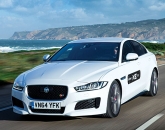 Only a few marques that are still on the road today have the distinguished heritage and rich history of Jaguar. Evolving from the Swallow Sidecar Company founded by William Lyons in 1922, the name “Jaguar” was born in 1935 to reflect the speed and sleek power of the cars that his company was then producing.
Only a few marques that are still on the road today have the distinguished heritage and rich history of Jaguar. Evolving from the Swallow Sidecar Company founded by William Lyons in 1922, the name “Jaguar” was born in 1935 to reflect the speed and sleek power of the cars that his company was then producing.
It was really in the period after World War II, that Jaguar created the cars for which it has become so famous. In 1948 Jaguar launched the XK120 (so called because it could do 120mph), the first of one of the greatest sports car series of all time. Jaguar soon realised that it also had the successful makings of a potentially winning competition car. The XK120C, or C-type as it is more commonly known, was ready just in time for the 1951 Le Mans 24hour race. Car number 20 driven by Peter Walker and Peter Whitehead won on its debut. In 1953, Jaguar introduced the disc brake (developed in conjunction with Dunlop) to the C-type and the world. This meant that the car’s brakes did not ‘fade’ and that the Jaguar could brake much later than the competition – a very important aspect when reducing speed from 150mph on the three-and-a-half-mile straight, Mulsanne. Jaguar finished 1st, 2nd and 4th at Le Mans that year. The XK120 was followed by updates XK140 and XK150 and the C-type by the famous D-type. In 1956 Jaguar became the first manufacturer to win Le Mans and the Monte Carlo Rally in the same year which led to a knighthood for Lyons. If the 1950s was a golden era for Jaguar with five victories at Le Mans by the end of the decade, then the “Swinging ‘60s” was perhaps an even more special decade. Building upon its racing success and popularity amongst Hollywood film stars, such as Robert Mitchum who drove XKs, the world beating XK engine and the cars needed to be updated and Jaguar needed to come up with a sensational new car. This duly arrived in 1961 with the launch of the E-type (or the XKE as it was known in the US). This is a car which perfectly captured the spirit of the time. Perhaps the most famous sportscar (if not car) of all time, this automotive icon was built for the next 13 years. It is a car that is still beautiful and yet eminently useable today, and whilst the Series III is perhaps the most practical to drive, the Series I is still the pursist’s choice in either coupe or roadster form.
Another very practical and useable, yet stylish and iconic Jaguar from this period is the 3.8 Mark 2 saloon. With an enlarged 3.8litre XK engine producing around 220hp, the Mark 2 was favoured by crooks and villains as a getaway car, and subsequently utilized by the British Police to chase them. Fastandpowerful,thiswas a very sophisticated vehicle with a luxurious and elegant interior filled with leather and wood veneer. Fitted with air-conditioning, a Jaguar Mk2 is a car that makes a very good classic that can be used everyday in all conditions, including heavy traffic.
Perhaps the finest Jaguar saloon car – the XJ6 – was introduced in 1968. This was the last masterpiece of Sir William, who retired in 1972. The XJ6 met with immediate public approval, with its distinctive looks and well-appointed refinement. Again an excellent useable classic, it is also available in the larger engine V12 version.
In 1975 the XJ-S was launched. The sports car of the XJ series, the XJ-S replaced the incredible E-type. Like the E, available as a coupe or convertible, the XJ-S is a wonderful sports tourer and another classic that is well suited to the rigours of modern motoring.
Jaguar has a great racing pedigree and continues to make some lovely cars to this day. The Jaguar name (along with its sister, Daimler) epitomises grace and style and is synonymous with classic cars of the best kind. There is a model for everyone and every budget. Whether a sporting saloon like the Mk 2 or XJ, a sports car like the XK or an iconic E-type, or perhaps the legendary C or D-type, Jaguar truly does provide, “a unique blend of style, luxury and performance.”
Click here to see the published article.











